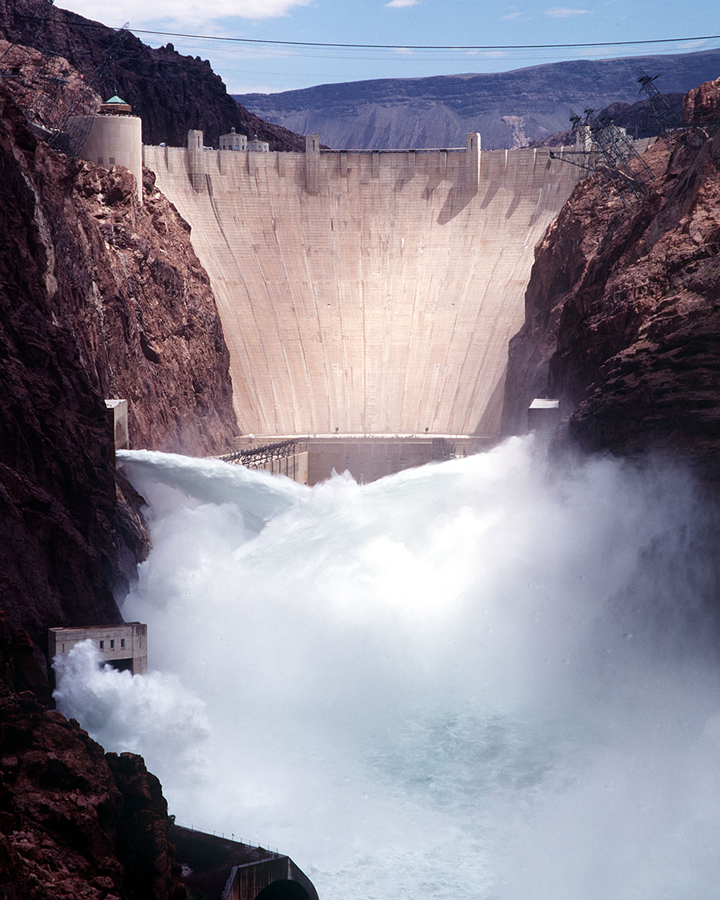With the energy transition away from fossil fuels and coal a top priority among many policymakers and voters, hydropower stands to play a much larger role in how we power this world in the coming years. Not only is it clean – CO2 is emission free – and renewable, but it can be used for water/waste management, water distribution and irrigation control. Perhaps the stronger argument for hydropower is that it provides ancillary services to the grid, which are vital to maintaining continuous power during a significant weather event. The 2021 “snow-pocalypse,” as it’s been dubbed by Texas residents, and the ensuing power outages, are proof that our grid needs all the help it can get.
Other renewables such as wind and solar are variable, and hydropower, particularly pumped storage hydropower (PSH), can pick up the slack when they are not producing power. PSH involves a dam with two reservoirs, an upper and a lower one, and a turbine. It can store energy by pumping water into the upper reservoir; when the energy is needed, the water will be released into the lower reservoir turning the reversible Frances turbines to create energy. The PSH cycle maintains an approximately 80 percent efficiency rate.
Additionally, PSH is the most massive battery technology out there and it provides system and balancing services to the grid. It is large-scale, cost efficient and the lowest cost for energy storage in existence. A dam has a lifespan of 100 years and hydro storage plants have more than 40, so the large cost that is required for initial investment is offset by the production lifespan. It is an incredibly efficient use of energy and resources as, by the end of its lifespan, it will have provided more than 150 times the amount of energy used to construct it – beating out all other solutions by far. Also, closed loop hydro plants do not need to be near a river and can be put wherever grid support is required.

A metaphor by Direct Energy Business that explains why it is so crucial to add reactive power to the grid suggests thinking of the energy transmission system like the municipal water system and voltage like water pressure. Water will not run through the pipe without pressure, but too much pressure will cause the pipes to explode. PSH can provide reactive power to the grid to keep voltage levels steady by absorbing power when it isn’t needed and generating it when it is. PSH can regulate frequency of voltage using synchronous inertia, or kinetic energy, by increasing and decreasing the speed of the rotating mass to balance supply and demand. PSH can employ virtual inertia by using the energy stored within it when there is a decrease of frequency in the network.
Grid stabilization is made possible so that low-inertia, variable renewables, such as wind and solar, can benefit from the high inertia of the revolving mass. The increasing number of intermittent sources decreases the grid’s inertia, leading to instability. PSH allows these variable renewables to enter the grid without causing problems and be transmitted large distances. Future technology is leading to a grid with far less rotating mass and will be relying more on hydropower for its power storage and inertial grid stability benefits. Ninety-three percent of the U.S. storage capacity, or 22.9 GW, is accounted for by water storage, which means that PSH takes the storage capacity of any other battery and multiplies it by 100 – blowing the competition out of the water, so to speak.
 PSH has black-start capabilities which means that it can go from off to on and distribute power without assistance from the power system. PSH also has variable speed capability in which the pumping process can be varied over a range of outputs, giving plant owners more flexibility. They can now yield voltage frequency assistance in both directions – pump or turbine mode with faster response times in seconds and even milliseconds in certain cases.
PSH has black-start capabilities which means that it can go from off to on and distribute power without assistance from the power system. PSH also has variable speed capability in which the pumping process can be varied over a range of outputs, giving plant owners more flexibility. They can now yield voltage frequency assistance in both directions – pump or turbine mode with faster response times in seconds and even milliseconds in certain cases.
The western United States is home to some of the largest hydropower dams. Washington, California and Oregon are the sites with the highest concentration of hydroelectric generation capacity. The U.S. hydropower plant with the greatest generating capacity is the Grand Coulee Dam in Washington. Of all states East of the Mississippi river, New York can boast of having the most conventional hydroelectric generating capacity, the next being Alabama. A whopping 79,946 megawatts (80 million kilowatts) total generation capacity in the U.S. in 2020, and the breakdown is as follows: 27% from Washington, 13% from California, 10% from Oregon, 6% from New York, and 4% from Alabama.
 China is home to the world’s largest hydropower dam, the Three Gorges Dam, which is located on the Yangtze River. Its construction began in 1994 and, when completed in 2006, it was the world’s largest structure, period. The accompanying hydroelectric plant was built in phases and took an additional six years to reach its maximum operating potential. The initial idea is that it would help with flooding, but this appears to be untrue, and the dam is actually a bit of a sore topic among environmentalists, who cite the elimination of countless rare archeological and architectural locations and natural features. The dam is massive and stands at an astonishing 7,660 feet long and 607 feet tall and contains 37 million cubic yards of concrete. The Three Gorges Dam is also the most productive one worldwide, at a generation capacity of 22,500 megawatts. In 2020, it set a world record by producing 111.88 kilowatt hours of electricity.
China is home to the world’s largest hydropower dam, the Three Gorges Dam, which is located on the Yangtze River. Its construction began in 1994 and, when completed in 2006, it was the world’s largest structure, period. The accompanying hydroelectric plant was built in phases and took an additional six years to reach its maximum operating potential. The initial idea is that it would help with flooding, but this appears to be untrue, and the dam is actually a bit of a sore topic among environmentalists, who cite the elimination of countless rare archeological and architectural locations and natural features. The dam is massive and stands at an astonishing 7,660 feet long and 607 feet tall and contains 37 million cubic yards of concrete. The Three Gorges Dam is also the most productive one worldwide, at a generation capacity of 22,500 megawatts. In 2020, it set a world record by producing 111.88 kilowatt hours of electricity.
 Globally, about 250 GW of hydropower projects are in the works, and new technology can help us to increase the potential of existing plants. There are several projects under construction worldwide such as: the 80 megawatt Rusumo Falls on the border of Tanzania and Rwanda, additions that bring the Tarbela Hydropower project in Pakistan to 3,478 megawatts of generation capacity, Site C on the Peace River in Canada with a production expectancy of 5,100 gigawatts annually, the Grand Inga in the Democratic Republic of Congo with an expected 42,000 megawatt generating capacity, and the Belo Monte in Brazil with a 233 megawatt generation capacity.
Globally, about 250 GW of hydropower projects are in the works, and new technology can help us to increase the potential of existing plants. There are several projects under construction worldwide such as: the 80 megawatt Rusumo Falls on the border of Tanzania and Rwanda, additions that bring the Tarbela Hydropower project in Pakistan to 3,478 megawatts of generation capacity, Site C on the Peace River in Canada with a production expectancy of 5,100 gigawatts annually, the Grand Inga in the Democratic Republic of Congo with an expected 42,000 megawatt generating capacity, and the Belo Monte in Brazil with a 233 megawatt generation capacity.
In the U.S., we have plans for the Red Rock hydropower plant on the Des Moines River in Iowa, which will have a 36.4 megawatt generation capacity. Although there is quite a bit of generation capacity in the works, experts say that we will still need to double the amount of hydropower capacity worldwide to reach net-zero emissions by 2050 and, at this point, we are far from the mark!
Headline photo: The Grand Coulee Dam in Washington state.
Shannon West graduated with a Bachelor of Liberal Arts in Psychology from Texas State University, where she developed a knack for writing research papers and case study analyses. After years of helping friends edit their university papers and cover letters, she is now putting those skills to use by copy editing and writing here at OILWOMAN Magazine.
Oil and gas operations are commonly found in remote locations far from company headquarters. Now, it's possible to monitor pump operations, collate and analyze seismic data, and track employees around the world from almost anywhere. Whether employees are in the office or in the field, the internet and related applications enable a greater multidirectional flow of information – and control – than ever before.


